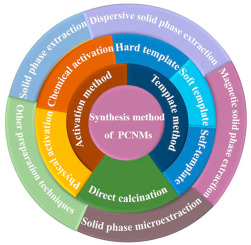Abstract
Porous carbon nanomaterials (PCNMs) have been favored by researchers because of their excellent properties, such as adjustable pore structure, high specific surface area, high porosity, good stability, and surface modifiability. At present, it has been widely used in the fields of adsorption, separation, catalysis, electrochemistry, and biomedicine. In recent years, new sample preparation methods based on porous carbon nanomaterials have emerged. This article outlines the preparation methods of PCNMs and their applications in solid phase extraction (SPE), dispersive solid phase extraction (DSPE), magnetic solid phase extraction (MSPE), solid phase microextraction (SPME), other sample preparation techniques, and prospects for them. (C) 2021 Elsevier B.V. All rights reserved.
Porous carbon nanomaterials (PCNMs) have been favored by researchers because of their excellent properties, such as adjustable pore structure, high specific surface area, high porosity, good stability, and surface modifiability. At present, it has been widely used in the fields of adsorption, separation, catalysis, electrochemistry, and biomedicine. In recent years, new sample preparation methods based on porous carbon nanomaterials have emerged. This article outlines the preparation methods of PCNMs and their applications in solid phase extraction (SPE), dispersive solid phase extraction (DSPE), magnetic solid phase extraction (MSPE), solid phase microextraction (SPME), other sample preparation techniques, and prospects for them. (C) 2021 Elsevier B.V. All rights reserved.

Keywords Plus:SOLID-PHASE EXTRACTIONMETAL-ORGANIC FRAMEWORKPOLYCYCLIC AROMATIC-HYDROCARBONSBAR SORPTIVE EXTRACTIONTEMPLATE-FREE SYNTHESISNANOPOROUS CARBONOXYGEN REDUCTIONNITROGENMICROEXTRACTIONADSORBENT
Published in TRAC-TRENDS IN ANALYTICAL CHEMISTRY,Volume 143;10.1016/j.trac.2021.116421,OCT 2021


